Common roof constructions
Interlocking single lap tiles can be used on a wide range of roof sub-structures. It would not be possible to illustrate every combination of roof structure and tile fixing methods. Nevertheless, the examples given below provide a good representative range of common pitched roof constructions.
Illustrations
- Domestic building with trussed rafters, masonry walls &ceiling insulation
- Domestic building with attic roof, timber frame, brick outer skin & insulation between & below rafters
- Domestic building with attic conversion, timber frame, brick outer skin & insulation between & below rafters
- Domestic building with SIPS [Structural Insulated Panels ] roof panels, timber frame, Brick outer skin with vertical tiling
- Non-domestic building with SIPS roof panels, SIPS external wall frame & vertical tiling
- Metal frame building with timber rafters, Tac Tray insulated structural liner trays, steel frame wall and brick outer leaf
The design of the roof substructure; eg rafters, insulated panels etc and the securing of the substructure to the building are not within the scope of this guide.
Domestic building with trussed rafters, masonry walls & ceiling insulation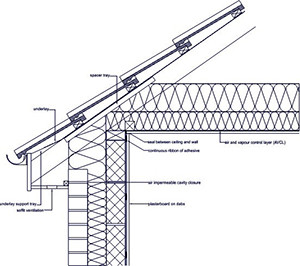
Insulation is laid between and across ceiling joists. Rafter roll enables ventilation air path from eaves into cold loft space.
For an efficient well-sealed ceiling install a separate AVCL between the ceiling and insulation, ensuring a good seal at perimeters, junctions and penetrations.
Seal all gaps between ceiling and masonry wall and seal all penetrations through ceiling using flexible sealant.
Domestic building with attic roof, timber frame, brick outer skin & insulation between & below rafters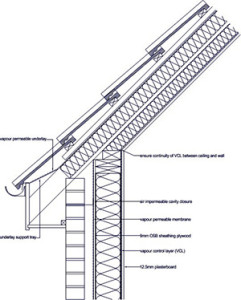
Tightly butt, tape and seal all joints between and around insulation boards using tape and jointing material to create an effective vapour control layer. Alternatively, install a separate vapour control layer between the ceiling and insulation, taking care to ensure a good seal at perimeters, Ensure continuity from ceiling VCL to wall VCL.
Seal all penetrations through ceiling using flexible sealant.
Use jointing tape at the ceiling to wall joint prior to the finish plaster being applied.
Fit an air-impermeable cavity closure at the top of the external wall.
Domestic building with attic conversion, timber frame, brick outer skin & insulation between & below rafters
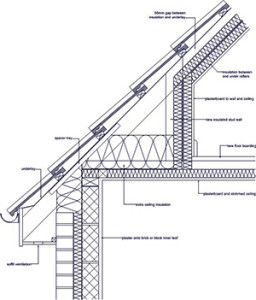
Same domestic building as example 2, but with attic conversion
![]()
Domestic building with SIPS roof panels, timber frame, Brick outer skin with vertical tiling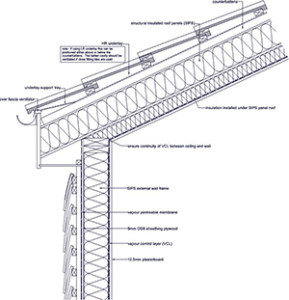
SIPS panels with extra insulation installed under roof panels.
Carefully seal all joints between panels and other elements such as walls, chimney stacks etc.
Install a vapour control layer between the SIPS panels and plasterboard ceiling, taking care to ensure a good seal at perimeters, junctions and penetrations. Ensure continuity from ceiling VCL to wall VCL. Laps should be not less than 50mm and sealed with adhesive or double-sided tape, ideally formed at solid supports such as joists or rafters.
Seal all penetrations through ceiling using flexible sealant.
Use jointing tape at the ceiling to wall joint prior to the finish plaster being applied.
Non-domestic building with SIPS roof panels, SIPS external wall frame & vertical tiling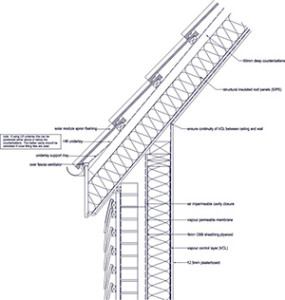
Leave a 5mm gap between panels and carefully seal by first injecting polyurethene foam and then applying a bead of bitumen sealant. carefully seal all joints between panels and other elements such as walls, chimney stacks etc.
Install a vapour control layer between the SIPS panels and plasterboard ceiling, taking care to ensure a good seal at perimeters, junctions and penetrations. Ensure continuity from ceiling VCL to wall VCL.
ideally formed at solid supports such as joists or rafters.
Seal all penetrations through ceiling using flexible sealant.
Use jointing tape at the ceiling to wall joint prior to the finish plaster being applied .
Metal frame building with timber rafters, Tac Tray insulated structural liner trays, steel frame wall and brick outer leaf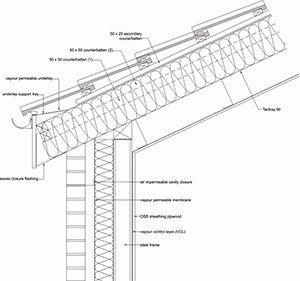
Tightly butt, tape and seal all joints using appropriate tape and jointing material to create an effective vapour control layer. Alternatively, install a separate vapour control layer between the ceiling and insulation, taking care to ensure a good seal at perimeters, junctions and penetrations. Ensure continuity from ceiling VCL to wall VCL. Laps should be not less than 50mm and sealed with adhesive or double-sided tape, ideally formed at solid supports such as joists or rafters.
Seal all penetrations through ceiling using flexible sealant.
Use jointing tape at the ceiling to wall joint prior to the finish plaster being applied.
